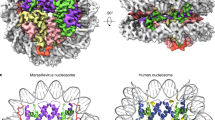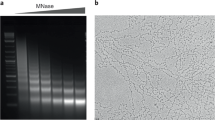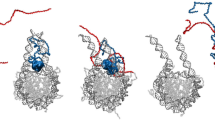Abstract
THE structure of chromatin, and the problems of organizing large lengths of DNA within the cell nucleus, are currently of considerable interest. It now appears established that the agents of chromosome structure are the histones found in conjunction with DNA in the chromosome, which may also act at some stage of genetic regulation. Of the five major types of histone fraction normally associated with mammalian genetic material, the lysine-rich histone F1 (or histone I) has some properties which set it apart from the others. It contains a very high proportion of lysine (27%), alanine (24%) and proline (9%) residues, these three alone making up more than 60% of the 216 residues of the molecule. As expected from the high proline content, F1 forms very little α-helix1 in aqueous salt solutions ; it also shows less tendency to aggregate than the other fractions. Interchain interactions, however, involving a specific section of the molecule are induced by salt2,3; a proposed scheme for this interaction, involving an antiparallel alignment of chain segments, has been presented3.
This is a preview of subscription content, access via your institution
Access options
Subscribe to this journal
Receive 51 print issues and online access
$199.00 per year
only $3.90 per issue
Buy this article
- Purchase on Springer Link
- Instant access to full article PDF
Prices may be subject to local taxes which are calculated during checkout
Similar content being viewed by others
References
Bradbury, E. M., Crane-Robinson, C., Phillips, D. M. P., Johns, E. W., and Murray, K., Nature, 205, 1315 (1965).
Boublik, M., Bradbury, E. M., and Crane-Robinson, C., Eur. J. Biochem., 14, 486 (1970).
Bradbury, E. M., and Rattle, H. W. E., Eur. J. Biochem., 27, 270 (1972).
Giannioni, G., and Peacocke, A. R., Biochim. Biophys. Acta, 68, 157 (1963).
Johns, E. W., and Forrester, S., Biochem. J., 111, 371 (1969).
Clark, R. J., and Felsenfeld, G., Nature New Biology, 229, 101 (1971).
Mirsky, A. E., Burdick, C. J., Davidson, E. N., and Littan, V. C., Proc. US Nat. Acad. Sci., 61, 592 (1968).
Ord, M. G., and Stocken, L. A., Biochem. J., 107, 403 (1967).
Shepherd, G. R., Noland, B. J., and Hardin, J. M., Arch. Biochim. Biophys., 142, 229 (1971).
Zubay, G., and Doty, P., J. Mol. Biol., 1, 1 (1959).
Murray, K., Bradbury, E. M., Crane-Robinson, C., Stephens, R. M., Haydon, A. J., and Peacocke, A. R., Biochem. J., 120, 859 (1970).
Johns, E. W., Biochem. J., 104, 78 (1967).
Oth, A., and Desveux, V., J. Polymer Sci., 23, 713 (1957).
Allfrey, V. G., in Histones and Nucleohistones (edit. by Phillips, D. M. P.) (Plenum Press, London, 1971).
Langan, T. A., Proc. US Nat. Acad. Sci., 64, 1267 (1969).
Author information
Authors and Affiliations
Rights and permissions
About this article
Cite this article
BRADBURY, E., CARPENTER, B. & RATTLE, H. Magnetic Resonance Studies of Deoxyribonucleoprotein. Nature 241, 123–126 (1973). https://doi.org/10.1038/241123a0
Received:
Revised:
Issue Date:
DOI: https://doi.org/10.1038/241123a0
This article is cited by
-
The structure of histone H1 and its location in chromatin
Nature (1980)
-
Selective removal of histone H1 from nucleosomes at low ionic strength
Molecular Biology Reports (1980)
-
RNA synthesis in isolated polytene nuclei from Chironomus tentans
Chromosoma (1977)
-
Cytochemical and ultrastructural studies on the synaptonemal complex of rat spermatocytes
Chromosoma (1977)
-
Nuclease cleavage of chromatin at 100-nucleotide pair intervals
Nature (1976)
Comments
By submitting a comment you agree to abide by our Terms and Community Guidelines. If you find something abusive or that does not comply with our terms or guidelines please flag it as inappropriate.



